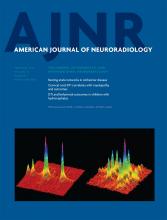Index by author
Merchant, T.E.
- PediatricsYou have accessImaging Changes in Very Young Children with Brain Tumors Treated with Proton Therapy and ChemotherapyN.D. Sabin, T.E. Merchant, J.H. Harreld, Z. Patay, P. Klimo, I. Qaddoumi, G.T. Armstrong, K. Wright, J. Gray, D.J. Indelicato and A. GajjarAmerican Journal of Neuroradiology February 2013, 34 (2) 446-450; DOI: https://doi.org/10.3174/ajnr.A3219
Mikulis, D.J.
- BrainYou have accessIntracranial Atherosclerotic Plaque Enhancement in Patients with Ischemic StrokeM. Skarpathiotakis, D.M. Mandell, R.H. Swartz, G. Tomlinson and D.J. MikulisAmerican Journal of Neuroradiology February 2013, 34 (2) 299-304; DOI: https://doi.org/10.3174/ajnr.A3209
Miley, J.T.
- FELLOWS' JOURNAL CLUBNeurointerventionOpen AccessMicrocatheter to Recanalization (Procedure Time) Predicts Outcomes in Endovascular Treatment in Patients with Acute Ischemic Stroke: When Do We Stop?A.E. Hassan, S.A. Chaudhry, J.T. Miley, R. Khatri, S.A. Hassan, M.F.K. Suri and A.I. QureshiAmerican Journal of Neuroradiology February 2013, 34 (2) 354-359; DOI: https://doi.org/10.3174/ajnr.A3202
This study addresses the relationship among procedure time, recanalization, and clinical outcomes in patients with acute ischemic stroke undergoing endovascular treatment. Demographics, NIHSS scores before and 1 day after the procedure, and modified Rankin Scale scores were assessed in 209 patients. Patients with procedure times ≤30 minutes had lower rates of unfavorable outcome at discharge compared with patients with procedure times ≥30 minutes. Rates of favorable outcomes in endovascularly treated patients after 60 minutes were lower than rates observed with placebo treatment. Unfavorable outcome was positively associated with age, admission NIHSS strata, and longer procedure times.
Milles, J.
- BrainYou have accessMagnetization Transfer Imaging in Premanifest and Manifest Huntington Disease: A 2-Year Follow-UpS.J.A. van den Bogaard, E.M. Dumas, E.P. Hart, J. Milles, R. Reilmann, J.C. Stout, D. Craufurd, C.R. Gibbard, S.J. Tabrizi, M.A. van Buchem, J. van der Grond and R.A.C. RoosAmerican Journal of Neuroradiology February 2013, 34 (2) 317-322; DOI: https://doi.org/10.3174/ajnr.A3303
Missonnier, P.
- BrainOpen AccessIndividual Classification of Mild Cognitive Impairment Subtypes by Support Vector Machine Analysis of White Matter DTIS. Haller, P. Missonnier, F.R. Herrmann, C. Rodriguez, M.-P. Deiber, D. Nguyen, G. Gold, K.-O. Lovblad and P. GiannakopoulosAmerican Journal of Neuroradiology February 2013, 34 (2) 283-291; DOI: https://doi.org/10.3174/ajnr.A3223
Montisci, R.
- Technical NoteYou have accessCarotid Artery Wall Thickness Measured Using CT: Inter- and Intraobserver Agreement AnalysisL. Saba, R. Sanfilippo, R. Montisci, J.S. Suri and G. MallariniAmerican Journal of Neuroradiology February 2013, 34 (2) E13-E18; DOI: https://doi.org/10.3174/ajnr.A2796
Morreale, M.
- BrainYou have accessStructural Brain MR Imaging Changes Associated with Obsessive-Compulsive Disorder in Patients with Multiple SclerosisE. Tinelli, A. Francia, E.M. Quartuccio, M. Morreale, G.M. Contessa, S. Pascucci, E. Sbardella, C. Pozzilli and P. PantanoAmerican Journal of Neuroradiology February 2013, 34 (2) 305-309; DOI: https://doi.org/10.3174/ajnr.A3210
Mushlin, A.I.
- EDITOR'S CHOICEBrainOpen AccessEvaluating CT Perfusion Using Outcome Measures of Delayed Cerebral Ischemia in Aneurysmal Subarachnoid HemorrhageP.C. Sanelli, N. Anumula, C.E. Johnson, J.P. Comunale, A.J. Tsiouris, H. Riina, A.Z. Segal, P.E. Stieg, R.D. Zimmerman and A.I. MushlinAmerican Journal of Neuroradiology February 2013, 34 (2) 292-298; DOI: https://doi.org/10.3174/ajnr.A3225
Ninety-six patients with SAH were evaluated with CT perfusion for cortical deficits and these were correlated with primary (permanent neurologic deficits and infarctions) and secondary (delayed cerebral ischemia manifesting as clinical deterioration) outcome measures. One-third of patients developed permanent neurologic deficits (78% showed CT perfusion defects), infarctions developed in 18% (88% had perfusion defects), and delayed cerebral ischemia was found in 50% (81% had perfusion defects). The most common perfusion abnormalities were reduced CBF and prolonged MTT.
Nakamura, T.
- Head & NeckYou have accessHead and Neck Tumors: Assessment of Perfusion-Related Parameters and Diffusion Coefficients Based on the Intravoxel Incoherent Motion ModelM. Sumi and T. NakamuraAmerican Journal of Neuroradiology February 2013, 34 (2) 410-416; DOI: https://doi.org/10.3174/ajnr.A3227
Nguyen, D.
- BrainOpen AccessIndividual Classification of Mild Cognitive Impairment Subtypes by Support Vector Machine Analysis of White Matter DTIS. Haller, P. Missonnier, F.R. Herrmann, C. Rodriguez, M.-P. Deiber, D. Nguyen, G. Gold, K.-O. Lovblad and P. GiannakopoulosAmerican Journal of Neuroradiology February 2013, 34 (2) 283-291; DOI: https://doi.org/10.3174/ajnr.A3223








